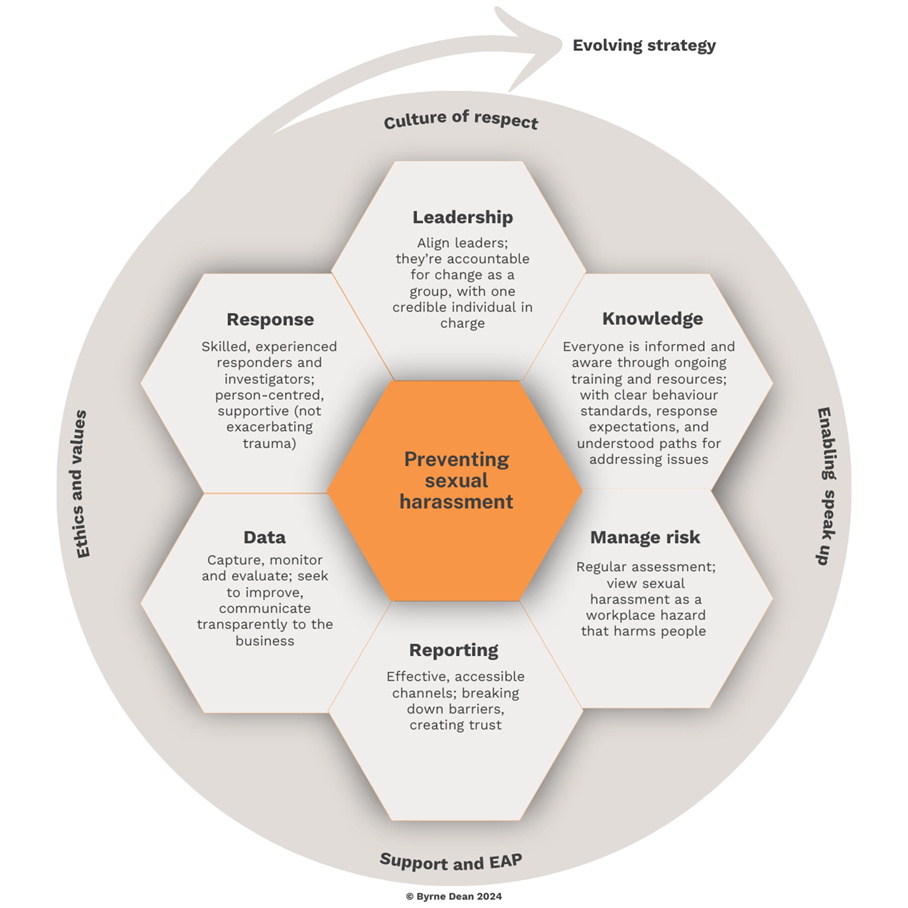Sexual harassment in the workplace remains a pervasive and troubling issue, undermining the dignity, safety, and equality of individuals, particularly women. Despite the legal advancements and frameworks designed to address this issue, such as the Prevention of Sexual Harassment (POSH) Act, 2013, the challenge persists due to deep-rooted societal attitudes, gender stereotypes, and inadequate enforcement mechanisms. This complex issue not only affects the personal and professional lives of women but also hinders organizational growth, as it creates toxic environments that inhibit productivity, collaboration, and trust.
- To effectively combat sexual harassment in the workplace, it is crucial to understand its underlying causes, the existing legal measures, and the societal factors that perpetuate it. This requires a comprehensive, multi-faceted approach—one that involves a combination of legal reforms, workplace policy changes, and cultural transformation at the societal level. In this context, addressing the causes of harassment, strengthening legal frameworks, redefining gender roles, and implementing supportive workplace cultures are all essential elements of a broader strategy to eradicate this issue. By exploring these dimensions, we can develop a more inclusive, respectful, and equitable work environment for all individuals.
Understanding the Causes of Sexual Harassment
Sexual harassment stems from entrenched power dynamics, gender stereotypes, and inadequate organizational practices. Key causes include:
1. Male Domination in Workplaces: Male-dominated workplaces often foster power imbalances where women face pressure to comply with sexual demands for career progression.
- The lack of female representation and support networks exacerbates these challenges, creating environments where harassment is normalized.
2. Online Harassment and Cyberattacks: The digital age has introduced new forms of workplace harassment, such as trolling, threats, and circulation of abusive content like vulgar messages or images.
- The anonymity of the internet emboldens perpetrators, while remote work has increased the vulnerability of women to cyber harassment.
3. Legal Non-Compliance by Employers: Many organizations fail to comply with the POSH Act, which mandates the formation of an Internal Complaints Committee (ICC) in workplaces with 10 or more employees.
- Ineffective ICCs, inadequate resources, and lack of training discourage victims from reporting incidents, perpetuating a culture of silence.
Recommendations to Address Sexual Harassment
To combat sexual harassment effectively, a multidimensional strategy is essential, focusing on education, policy changes, and cultural transformation.
1. Portrayal of Women in Cinema: Media plays a critical role in shaping societal attitudes. Indian cinema often reinforces gender stereotypes by portraying women in passive roles.
- Changing the narrative to depict women as leaders, diplomats, business executives, and other powerful roles can inspire societal respect for women in positions of authority.
2. Gender Awareness Training Programs: These programs can educate employees about power dynamics, gender inequality, and appropriate workplace behavior.
- Training should challenge systemic barriers, promote equality, and encourage men to become allies in combating harassment.
3. Redefining Masculinity and Femininity: Traditional notions of masculinity, associated with aggression and dominance, and femininity, linked to passivity and submission, perpetuate harassment.
- Masculinity should be redefined to reflect justice, compassion, and equality, while femininity should symbolize strength, autonomy, and active participation.
4. Creation of a Welfare Fund for Women: Women often face career disruptions due to maternity, caregiving responsibilities, or health issues, leading to financial instability.
- A welfare fund can provide financial support during these breaks and fund skill development programs, enabling women to re-enter the workforce without disadvantage.

Legal and Societal Measures
India has implemented various legal measures and societal initiatives to address sexual harassment.
1. Legal Frameworks
- Indecent Representation of Women Act, 1987: Prevents the objectification of women in media, which normalizes harassment.
- Vishakha Guidelines, 1997: Established employer responsibility to prevent and address sexual harassment, laying the foundation for the POSH Act.
- Bharatiya Nyaya Sanhita, 2023 (BNSS): Includes specific provisions for sexual offenses against women and children in Chapter V, strengthening the legal recourse for victims.
2. Government Initiatives
- SHe-Box: An online portal allowing women to file harassment complaints anonymously, ensuring privacy and safety.
- Working Women Hostels: Provide safe, affordable housing for women, addressing mobility and safety challenges in urban areas.
Addressing Organizational and Cultural Challenges
1. Strengthening the POSH Act’s Implementation
- Organizations must prioritize the establishment and training of ICCs to ensure unbiased and effective handling of complaints.
- Regular audits, awareness campaigns, and compliance checks can hold employers accountable.
2. Promoting a Supportive Workplace Culture
- Encouraging open discussions on harassment and gender equality can help dismantle the culture of silence.
- Organizations should adopt zero-tolerance policies and transparent grievance mechanisms to build trust among employees.
Role of Media and Society
The media’s role in shaping societal norms is crucial. Misrepresentation of women as passive or subservient characters in films and advertisements reinforces harmful stereotypes. Shifting to portrayals of empowered women in positions of authority can challenge ingrained gender biases.
Societal attitudes toward masculinity and femininity also require transformation. Encouraging values like empathy, equality, and mutual respect in both men and women will foster a more balanced and inclusive workplace culture.
Challenges and Future Directions
Despite progress, challenges remain:
1. Underreporting: Fear of stigma, retaliation, and lack of trust in grievance mechanisms discourage women from filing complaints.
2. Weak Legal Compliance: Many workplaces fail to implement the POSH Act effectively, leaving women vulnerable to harassment.
3. Cultural Resistance: Deep-seated patriarchal norms continue to perpetuate gender inequality, making change slow and difficult.
Addressing these challenges requires sustained efforts from policymakers, organizations, and society as a whole. By integrating legal reforms, awareness campaigns, and cultural shifts, India can create safer and more equitable workplaces.
Conclusion
Sexual harassment at the workplace is a complex issue that demands a holistic approach. While legal frameworks like the POSH Act and initiatives such as SHe-Box and Vishakha Guidelines provide critical support, their success depends on robust implementation and cultural change.
Efforts to redefine societal perceptions of gender, strengthen workplace policies, and ensure financial and professional support for women are essential steps toward creating an environment of equality and respect. By addressing the root causes of harassment and empowering women through legal, societal, and organizational reforms, India can pave the way for a future where workplaces are truly inclusive and free from harassment.
| Main question: While legal and institutional mechanisms are essential, societal change is equally important in addressing sexual harassment in the workplace. How can societal attitudes toward gender equality and power dynamics be transformed to prevent workplace harassment? |







